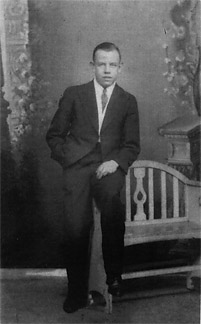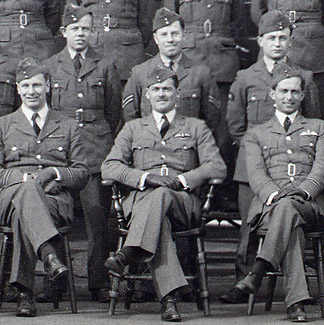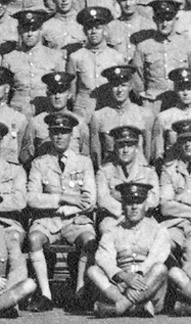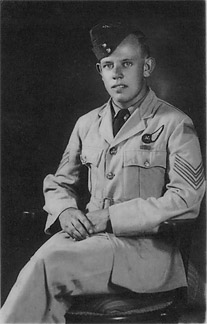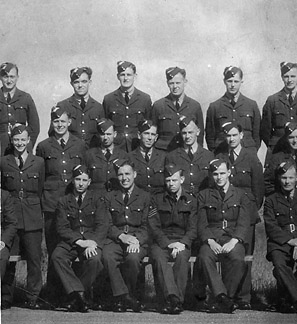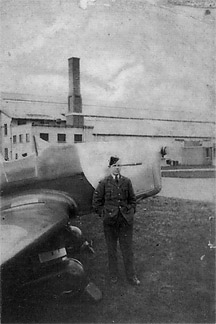 |
 |
|||||||
|
Sgt William Wright 550968 RAF KAO 1 February 1945 In the Spring of 1913, one Robert Wright of County Durham married Sarah H Chapman, at Lanchester, some 12 miles from Bishop Auckland. In the Summer of 1919, at High Etherley, just 4 miles from Bishop Auckland, baby William Wright was born. William’s father was certainly Robert Wright of High Etherley, and his mother’s maiden name was certainly Chapman. And for some period in mid to late 1930s, young William Wright certainly attended King James I Grammar School in Bishop Auckland. Although Robert Wright and William Wright were pretty popular names in the County Durham of Victorian and Edwardian days, these records seem likely to be the bare account of William’s immediate family and early childhood. By the Summer of 1937, as Britain emerged from the Great Depression, war loomed ever closer in Europe. Aged about 18, William Wright gave thought to the future and enlisted in the rapidly expanding RAF.
An undated studio portrait in civvies, with just the faintest hint of a grin. Mildenhall In one of the quirks of the Service, his seven flights in July and August were deemed not to count towards official flying hours, the first two pages of his Observer’s and Air Gunners Flying Log Book being smartly pasted together. Still, on one notable day his pilot was Squadron CO S/Ldr RJA Ford. Flying in Audax K1998, they carried out a forced landing exercise. Grantham By October the Audaxes had all gone. That month he recorded another 6hrs 05mins flying with ‘B’ Flight, mostly reconnaissance exercises but also spending an hour on an R/T test flight in box formation. F/O Withy was now the Flight Commander. November was busier still, despite the approach of Winter, with 12 flights logged for 11hrs 10mins flying time. Much of it was with Siddaway at the stick, on bombing, R/T and navigation exercises, with plenty of work on WS&D (the vital wind speed and direction estimate, essential for successful dead-reckoning navigation and for good results with the Course Setting Bomb Sight). The duty roster was not quite so busy in December, with 10 flights amounting to 7hrs 15min in the air for Wright, half of that on R/T range and frequency testing. Seven of his flights were with Withy as OC ‘B’ Flight, who was promoted to F/Lt during the month. By the end of the year, the Squadron was preparing to send a detached Flight to Aldergrove in Northern Ireland, for 2 Armament Training Camp duty. In January, with half the Squadron aircraft at Aldergrove to assist in Air Gunner training for the month, flying duties at Grantham were lighter still. Wright logged just 4hrs 50min in the rear cockpit, over eight flights. Two of them were with the Australian P/O WH (Bill) Edwards, one briefly up with P/O GD Jones: the well-regarded “Potato”, who, like Wright, was still with the Squadron in the valiant but bitter days in Greece three years later. Tensions rising At Grantham that month, with the Squadron back together, the pace quickened. William added 15 flights and 22 flying hours to the Log. Much of it was W/T work while carrying out bombing and camera-gun exercises, often over North Coates Fitties. The first two weeks of March were also busy, with 13 flights for another 11hrs 35min logged. That Spring, the byzantine diplomatic overtures came to naught. On 11 March the Austrian Nazi Party mounted a successful coup. Massed German troops crossed the border the next day, met with cheering crowds. Formal annexation by Germany followed on 13 March. By coincidence, that day the Squadron was given notice of an impending move overseas, “probably to Helwan”.
At home, pretty much on the eve of departure for the Middle East. CO S/Ldr Ford (centre, front) and his two Flight Commanders: F/Lt Barclay of ‘A’ Flight on the left and F/Lt Withy of ‘B’ Flight, on the right. From the formal Squadron photograph. Standing on the left, behind Barclay and Ford, is Aircraftman Wright (no badges or badges apparent at this date). “Titch”, they dubbed him in Greece. Plainly he was taller than both the Corporal next to him and Aircraftman GL Hoyes, far right—the shortest man in many a Squadron photo from 1938 to 1940. In a Blenheim turret, shorter stature was to be a positive advantage for a gunner: especially when a quick exit was called for. The Squadron was busy from mid-March, packing for the move, sending their aircraft away for crating, plus postings in and out to be ready for the three Flight establishment of a mobile overseas Squadron. On 1 April, co-incidentally the RAF’s 20th anniversary, all personnel were sent on embarkation leave. Returning to duty on 24 April, they left Grantham by train early on 30 April, boarding HMT Lancashire at Southampton that afternoon. Among the 211s was another air gunner, Geoff Grierson, whose collection includes photographs of the voyage. With them and also bound for service in Egypt and the Middle East were the men of No 80 (Fighter) Squadron and No 113 (Bomber) Squadron. To Egypt On 14 June, William was back in the air once more, map-reading passenger to Sgt Watkins as they took a look over their new patch. The remainder of the month was spent mainly on recco flights and air gunnery exercises, clocking up another 10 flights and 9hrs 35min in the Log, most often with the Australian P/O Farrington. July looked set to pass at much the same pace, as they found their way about the local scene, the Western Desert, the Delta, and the Canal area. To Palestine Transport for the Squadron was to be provided by the Vickers Valentias of No 216 (Bomber Transport) Squadron, shown in Geoff Grierson’s photographs. On 19 July, it was ‘B’ Flight’s turn, AC1 William Wright boarding one of the Valentias early that morning for the 2hrs 40min flight across the Northern Sinai desert to their new home, 10 miles or so South East of Jaffa. From Ramleh, and later from Semakh in the North, the Squadron was to provide reconnaissance, convoy escort and, by the XX radio call system, rapid air assistance to Transjordan Frontier Force and Palestine Police parties if under ground attack. After some extended cross-country flights for familiarisation and a single XX practice call, by the third week of August Wright was on operations. By the end of September he had added 31hrs 40min to the Log in 23 flights in the rear cockpit, 15 of which were operational trips on reconnaissance, convoy or infantry escort, one live XX call, and one bombing raid. His first full year of flying duties with 211 Squadron ran to 119hrs 30min in all, 22hrs 50min of which were on ops. Munich and after On 30 September Chamberlain, Daladier of France, Mussolini and Hitler signed the Munich Agreement, the dismemberment of Czechoslovakia being the price for a further year of apparent peace. The incomplete move of the whole Squadron to Daba was smartly recast as a brief practice deployment, which kept them all well occupied in the first week of October. Wright, with either P/O Couchman or F/O Mills at the controls, made six flights in and out of Daba in two days, to and from Helwan and the Aircraft Depot Middle East (at Aboukir, near Alexandria). By 7 October, everyone was back at Helwan once more, in time to practice hard for the mass formation “show the flag” fly-past over Cairo on 18 October, followed the next day with a formal review at RAF Heliopolis by the Egyptian War Minister. By that date William had accumulated another 17hrs 25min flying, all of it with Mills and Couchman.
William standing, centre, rear row. From the Squadron formal photograph. The good winter weather of November brought a flurry of bombing, gunnery and bomb-sight exercises as the Squadron underwent it’s annual armament assessment. Wright flew as Bomb-aimer, Gunner, and occasionally as Wireless Operator, mostly for Couchman. In 25 flights, two of them at night, he amassed another 17hrs 10min in the air. The exercises continued in early December, broken mid-month by a mass visit of Squadron aircraft to Ismailia, to join the search for one of the new Blenheims, missing over the Sinai. Then it was back to Helwan to finish the armament exercises with a bit of a flourish: as passenger on no less than three high-level dive bombing exercises, with F/O Boehm, Sgt Pike, and P/O Couchman. Another 21hrs 45 in the log, in 18 flights, for a service flying total of 175hrs 50min. 1939 For Wright, the first flying duty of the year brought a break in routine. At Helwan they shared the aerodrome with 45 Squadron and its Vickers Wellesleys, a more modern monoplane design with a crew of three. On 12 January, with Sgt GJCP Bateman of 45 Squadron as Pilot, Wright as Wireless Op and presumably an Observer to navigate, they set off in Wellesley K7774 (marked 45 ‘U’) on an extended Service Mail cross-country from Helwan to Helio, to Ismailia and on to Ramleh, returning by the same route the next day. Notably, the multi-leg outward and home journeys each took only about 2 hours. Back in July, the doughty Valentias of 216 Squadron had droned away for 2hrs 40min on the single leg from Helwan direct to Ramleh. On 21 January the main body of the Squadron made the move to Ismailia. The ground party in convoy was photographed by WOp/AG Ralph Wingrove. Wright was more fortunate, flying with P/O Couchman in Hind K6853. Thereafter, the pace of flying was pretty steady from late January to the end of April. Somewhat less intense than it had been for November and December 1938 at Helwan, there was plenty of variety in the training programme at Ismailia. Formation flying and R/T work; plenty of navigation with D/F exercises, more WS&D work and running fixes; photography; gunnery; and High Level bombing exercises at 6,000 and 8,000 feet were followed by wider afield cross-country visits to desert landing grounds and El Daba. For Wright, as Wireless Op, as Gunner, as Navigator and as Bomb-Aimer, much of this duty was carried out either for Couchman as Pilot or for Sgt Pike. Pete Collier’s name also appears quite often, as does F/O Boehm and F/Lt Spencer, OC ‘B’ Flight. March ended with a flourish, in a mass flypast for the new AOCinC RAF Middle East, Air Marshal Sir William Mitchell. April concluded with a move out to their War Station at Daba and from there a series of operational exercises staged via Mersa Matruh. By the end of the month, Wright had logged a total of 242hrs 50min flying, all but 10hrs of that in the Hinds of 211 Squadron. Blenheim days With their own conversion complete, the Squadron turned their hand to local Blenheim Delivery Flight (BDF) duties, ferrying Mark Is down to Aden for 8 Squadron at Khormaksar in May and June. Each trip came with the bonus of a return voyage by steam packet. Two of these jaunts fell to AC Wright, flying as W/Op to F/Lt Spencer in L8403 on 26 and 27 May; and again as W/Op to F/Lt Mills in L1526 from 16 to 18 June. Come July and training was in full swing, despite some by now familiar re-equipment problems: lack of spares, tools, and basic radio fit. Still, they kept at it, with a range of practice attacks, Low Level Bombing exercises, and cross-country flights as far afield as Wadi Natrun and El Daba. By late Summer in Europe, tensions were again near breaking point, this time between Germany and Poland. As the situation worsened, the Squadron moved forward once more to their War Station, El Daba. There in late August, a fresh challenge came William’s way: return to the UK with other volunteers from the Squadron, to ferry more Blenheims to the Middle East under the BDF system. He had just under 50 flying hours logged in them. The Phoney War By then he was attached to 101 Squadron, a Blenheim unit at West Raynham. The first month of Phoney War passed with 5 local flights in 101 Squadron aircraft. Then followed a perhaps frustrating period. Attached to 139 Squadron at Wyton, there was no flying for him at all for two months. Come the Battle of France in the Spring, the Blenheim Squadrons would be in the thick of it, but William would not be there. In early December, another chance came his way. With the Wellesleys now obsolescent for European theatre use, they were to be sent out to the Middle East for units there already so equipped (like 45 Squadron) and for others with even less modern aircraft (Fairey Gordons and Vincents). At RAF Sealand, a Wellesley Delivery Flight support unit had been put together—perhaps a more formal set-up in time of war than the sort of al fresco peacetime Blenheim service offered earlier by 211 Squadron in the Middle East. The WDFs and BDFs from the United Kingdom were no junket, however, with several aircraft lost at sea between September 1939 and April 1940. William had just four hours on Wellesleys. For his first WDF beginning on 22 December 1939 from RAF Sealand to Boscombe Down, perhaps not by happenstance his pilot was once again Sgt Bateman of 45 Squadron. Familiarity brought them scant luck, however. On 26 December they continued from Boscombe Down. William’s terse Log Book Remarks for the late morning flight in Wellesley L2682 noted: “Boscombe Down—Bordeaux. Forced landing 14 km from Angers. A/c u/s”. By 12 January 1940 they were back in the UK, still attached to RAF Sealand. Return to the Desert Curiously, the published history of K7735 records the aircraft’s presence in Egypt in very different terms: ”shipped to ME for REAF 14 Dec 39 but handed back for 47 Squadron”—perhaps reflecting an earlier intention; or, equally, the varied state of Middle East aircraft record keeping. In any event, Wright’s log is abundantly clear. Flying via Marignane, Tunis, and Hal Far on Malta, they reached Abu Sueir in the afternoon of 20 February 1940. Meanwhile, his 211 Squadron family had the situation well taped. At 12:30 the next day, Pike, now a Flight Sergeant, took him aboard Blenheim L8389 as passenger and whisked him straight back to Ismailia, where they landed 10 minutes later. The aerodromes were barely 10 miles apart. Later that afternoon, 21 April, Pike flew Wright out to their Desert home at El Daba. The Operations Record Book recorded the return of “two airmen from England on completion of BDF duties”, but for some reason dated that to 22 April. Apparently Pike had picked up both Wright and LAC Tickner, the Observer. Perhaps the elan of this gesture for an LAC Observer and AC Wireless Op caught the attention of Sgt Marpole, the Wellesley pilot. However it was, by June at the latest Marpole, too, was a member of 211 Squadron. F/Lt Pat Burnett, one of the two Squadron pilots of the late 1939 UK BDF party, had returned to the Squadron much earlier, on 4 January. On 26 February, William was back at normal duty, flying as W/Op to Burnett in Blenheim L1482 on a Low Level Bombing exercise at 2,000ft. The training continued steadily through the rest of February, March and April, not only bombing but formation flying, night flying, photography and survey work, and the occasional gunnery exercise. In all, 22 flights in 29hrs 15min flying time, with Burnett (OC ‘B’ Flight), P/O Delaney, P/O Collier, and with F/O Doudney among others. George Doudney had come out from the UK on a Blenheim Delivery Flight in late 1939. Attached to the Squadron from 5 October, he was posted in from late November, along with LS (Duke) Delaney, another BDF arrival. By late March 1940, Doudney was OC ‘B’ Flight. The Battle of France began on 10 May. Though unremarked in the Operations Record Book, that brought the Phoney War days to an end. The tempo of work had perceptibly increased, with the Air Defence of Egypt exercise on 7 May, while cross-country, photographic and HLB exercises continued into early June. The level of readiness was now high, all leave having been stopped in May. In January 1939 the RAF had recognised that non-pilot specialist aircrew (the Observers and the Wireless Operator/Air Gunners, initially) needed to be treated as full-time aircrew (AMO A.17/39). With the coming of war, the status of non-pilot aircrew was looked at afresh. From 27 May 1940, qualified Wireless Operator/Air Gunners were to be accorded the rank of Sergeant (AMO A.416/40 of 27 June). For some of the old hands, training on the job took a while longer to sort out but for William Wright, all was clear: he endorsed his Log Book Certificates sheet as Sgt WOp/AG with effect from 27 May 1940. By 7 June Sgt Wright’s flying totalled over 360 hours (including 13 by night), about 102 hours (6 by night) in 211 Squadron Blenheims. Operations: Libya From then on, the crew was pretty well settled: F/O George Doudney as ‘B’ Flight Commander and Pilot (and F/Lt from July), Sgt JJ Paddy Kavanagh as Observer; and Sgt William Titch Wright as Wireless Op/Air Gunner. From 11 June to the end of October 1940, Wright made 45 flights totalling 112hrs 35min, of which no less than 28 were operations over Italian targets in Libya and the Western Desert, all but two of them with his Flight Commander, F/Lt GB Doudney, most of them with Paddy Kavanagh or Bill Stack as Observer. His Log Book comments were typically brief: Date: 3/8 Hour: 1035 Aircraft Type and No: Blenheim L6658 Four Small Bomb Containers, then: two with 40lb bombs and two with 20lbs. In sum, the maximum internal load for a Blenheim I, of 1,000lbs. Flying with the bomb-bay doors off, to accommodate the containers and looking to increase the chance of hits, bombing ships from 15,000ft. On 28 October, Il Duce’s forces crossed the border from Albania into Greece. The Squadron stood down on 6 November to get ready for the RAF move to Greece. By then Sgt Wright had over 476 flying hours logged, over 40 hours of that at night. Preparing for re-deployment took an amount of work and dashing about, as they were sent from the Desert to Ismailia to get stores, spares, aircraft and personnel all up to establishment. Amid the bustle a “free” return trip to Heliopolis came William’s way, with The Bish, no less, as “driver, airframe” for three passengers. Across the wine-dark sea On 23 November the Air Party left Ismailia early in the morning, to stage through Fuka for the longish flight to Greece, overflying Crete en route to land first at Elevsis before making the short jump to Menidi. The next day, the Greyhounds of the Desert were “open for business” once more. Doudney, Kavanagh and Wright in L4926 led the ‘B’ Flight vic in a full (nine aircraft) Squadron operation, flying first to Larissa to refuel. The Squadron then headed North-West across wintry Greece for the first of many strikes on Valona (modern Vlore) on the Adriatic coast, principal port for Italian forces in Albania. Gloom: The Bish and co reported missing. That winter, 211 Squadron flew from Menidi in foul weather for dark miles across the mountainous Pindus, to make repeated attacks on Valona and Durazzo (Durres) and later against Italian forces on the ground in Southern Albania. By the end of the year, Sgt Wright had flown on a total of 34 raids in the Blenheims of his Squadron, the six in Greece all with George Doudney and flown in what were often indescribable weather conditions. The end in Greece The 6 January raid on Valona in Albania was “intercepted by seven Macchis” (Fiat G50s, apparently). The Blenheims also encountered heavy and accurate AA fire over the port. Their aircraft damaged, Doudney and co crash-landed on their return to Menidi, the incident recorded more prosaically on the Form 540. However, the raid was in fact a grim affair: P/O Campbell with Sgts Beharrel and Appleyard ditched L1487 to be taken prisoner-of-war, while F/O “Duke” Delaney and his crew Sgts Pollard and McCord crashed fatally in L8536 at Argyrokastron. His final op in Greece was the aborted 10 January raid against Italian troops retreating along the Kelcyre—Berat road. With low cloud down among the hilltops, the whole formation turned back. A number of their operations from Menidi were frustrated by the terrible Winter weather. When he resumed flying over a month later, the Squadron had moved forward to Paramythia. Late February was busy with numerous trips to and from Menidi, with F/O Austin or F/O “Buck” Buchanan, his ‘B’ Flight OC. On 25 March he was back at Paramythia once more, manning the turret for Sgt Davis in L8466 as the Squadron returned from its brief 22 March withdrawal to Menidi. When the final blow came at Paramythia on 13 April, Wright was back in Menidi, having flown out in the Greek civil Ju 52 SX-ACA “Athinai” of EEES AE 10 days earlier. When Pip Cox flew Blenheim L1837 out to Heraklion on Crete, 22 April, Wright was aboard as a passenger. To Palestine From 8 May Titch was already at Aquir with F/O Clutterbuck, staging out to H4 on the pipeline for raids the next day against Rutbah Fort in Mark IV Z5865 and again in Z5891, which promptly went u/s with a burst hydraulic pipe. By 11 May they were back at Aquir which, after an amount of Service muddle, was the Squadron’s home for the remainder of it’s time on operations in Palestine. By the time he left the 211s in early June 1941, Sgt William “Titch” Wright had accumulated 232 hours on Hinds (including 15 sorties in action over Palestine in late 1938) and 266 hours on Blenheim Is. He had flown on 39 operations as WOp/AG over Libya, Albania and Syria; 35 of them with George Doudney as ‘B’ Flight commander and most of those with Sgt JJ Kavanagh DFM as Observer. Posted to XI Squadron in Palestine, he continued operational flying with them against Vichy French targets in Syria. By the end of July 1941 he had completed another 17 sorties, mostly with F/Lt Rowbotham. Over 13 months in action from June 1940, he had taken part in a grand total of 56 operations in 332 flying hours on Mark I and Mark IV Blenheims with two Squadrons, in addition to the 15 raids of 1938 in Hinds.
In tropical kit, in the rank of Sergeant with AG badge. A relaxed studio shot and, despite the tropicals, apparently taken in the UK. The ribbon of the Africa Star gives a strong hint as to date: having been promulgated in June 1943, ribbon issue was authorised for other 211s in 1944. “AFRICA STAR His ribbon for the General Service Medal (Palestine Clasp) was yet to come, for some reason. The actual medals were issued only post-war: 1949 in Geoff Hoyes case, 1950 for my father. Screened A brief three day stopover there at the start of the trans-Africa ferry route, then it was a five day return trip to Heliopolis, as passenger aboard Bristol Bombay L5829 (pilot F/O Thorogood of 216 Squadron). At the end of September 1941 the flying time tally stood at 669:25 hours in all, 628 by day, 41:25 by night. In the usual course of events, tour-expired (screened) aircrew would be posted for a time as instructors to a training unit—both as a rest and to pass on their operational experience to raw aircrew. 211 Squadron had been stood down, as a unit, for just that task at Wadi Gazouza in the Sudan. Still, the time for “resting” an operational Squadron as a unit was now passing, in favour of non--operational posts for individual screened aircrew. Although RAF postings often seemed obtusely opaque to airmen, the difficulties of matching Squadron needs, aircrew survival, and aptitude for training were all being grappled with from mid 1941, in the light of lessons learned from the rapid expansion of aircrew training to the end of 1940. In William’s case, after three years in the Middle East in peace and war, he was for Home. In mid October his time at Hurricane House was up. A month amid the sand and canvas delights of Middle East Pool followed, until he boarded SS Stratheden on 16 November 1941 to disembark in the UK on 19 January 1942. There the war remained grim. Even as the Russian Winter dealt savagely with the Wehrmacht outside Moscow, on the other side of the world, Japan had struck at Hawaii, Malaya and Burma. His old Squadron was about to deploy to the Dutch East Indies to fight the Japanese advance. 1942 At Pembrey, 1 AGS had 39 Blenheims and 22 Lysander TTs on charge as target tugs, to provide gunnery practice up to OTU standard. Settled in, a week later they packed him off to 1 Air Armament School at Manby in Lincolnshire for six weeks, on No 16 Air Gunnery Instruction Course. The 1942 roster at 1 AAS was more varied than at Pembrey: about a dozen each of Wellingtons, Hampdens and Blenheims; with Lysanders TTs for the target towing. In his one week of flying there, Sgt Instructor Wright listed several Wellington sessions “Training AGs” in various exercises, and at the end of his time there, his Log Book was duly endorsed: qualified as Air Gunnery Instructor wef 10 April 1942. By 11 April he was back at Pembrey, instructing, though the flying element was sparse indeed: none at all in the Log Book until October, then five Blenheim flights, instructing for the old Vickers K turret once more. The eight months of gunnery instruction to mid-October 1942 added less than 11 flying hours to the Log Book. In late October 1942, Wright was posted to 14 Initial Training Wing, where aircrew recruits first found their feet. At Bridlington, on the North Sea coast of Yorkshire’s East Riding, at least Bishop Auckland was much closer: some 90 miles Northwards, through Whitby and Middlesborough. In late March 1943, 14 ITW was to move to Bridgnorth and focus on Air Gunner trainees. Perhaps that development accounted for Wright’s next posting, on 1 March: he was to stay in Bridlington, where the newly formed 1 Elementary Air Gunners School was to carry trainee AGs on from the ITW stage up to the standard for entry to Air Gunners School proper. At 1 EAGS he toiled away for a year with the trainee Air Gunners.
The print was made from a much larger group photograph, as is apparent from the men at the frame edge. Possibly 35 Course, from a brief notation on the print margin, possibly at 1 EAGS Bridlington. The men’s caps carry the white flash of the aircrew trainee, worn from ITW onwards until qualified as aircrew. Only Sgt Wright wears any badge: the AG wing and fist of lightning badge of his full WOp/AG trade. Here, for some reason, despite the general good humour on a sunny occasion, he regards the camera with a grim-set face. Sadly, while the changing tide of war became clearer during 1943, all was not well in the Wright family. That September in County Durham, William’s mother Sarah H Wright died, leaving William’s father Robert a widower at High Etherley. 1944
Undated, this standard small print was partly hand-coloured in blue. Although Wright never recorded flying in one, the two-seat Miles Magister was a common RAF sight, in frequent use as a unit or communications hack, and more numerously with training schools. A confident grin from William on a dull day at a Home Station. The badge on his right sleeve cannot quite be made out. It could be the fistful of lightning flash of the Wireless Operator but, equally, it could be the Royal Arms badge of a Warrant Officer. No Sergeant’s stripes nor LAC propeller badge visible. Given the late pattern blues and Home Station backgound, this would seem to be a shot as Warrant Officer, perhaps in 1944. And at home in High Etherley, there was personal warmth once more: Robert Wright and Millicent Etherington were wed in September 1944. Across the Channel, the Allied armies had at last breached Festung Europa and were advancing across France and the Low Countries towards Germany. As ever, the task of matching aircrew skills, training and numbers against operational needs, losses and wastage was difficult. By 1944, for example, the number of tour-expired Air Gunners well exceeded that number of Gunnery instructors needed. At 83 OTU, William’s posting ran for nearly eight months, from 29 March 1944 to 17 October 1944. At this period, a completed aircrew course at a night-bomber OTU was of three months duration. A washout seems hardly likely in his case. Perhaps the long period as Air Gunner Instructor, now passed, resulted in his return to the W/Op role—and in need of an extended refresher course on the more technical current radio kit. From 11 August to 12 October, he made 17 Wellington flights as Wireless Op and later as Scr W/Op, almost wholly on CCG exercises by day, with seven different pilots, all noted as with the Bomber Defence Training Flight of the OTU. In any event, whether instructing or on a W/Op refresher course, by mid-October his time at Peplow was up. The Log Book now showed over 700 hours in the air, over 50 at night. For multi-engine aircrew of the time, the HCUs provided the final polish for flying current types before joining an operational Squadron. On 18 October 1944 Wright was posted to No 1332 (Transport) Heavy Conversion Unit. They had just taken up residence at Nutts Corner near Belfast in Northern Ireland, equipped with 15 Short Stirlings, four Liberators and four Avro Yorks, to train transport crews. Gunnery behind him at last, he spent the six week course in the air as W/Op, twice in Short Stirlings by night, then four flights by day and by night in Avro Yorks with F/Lt Clarke as Pilot. He was ready for operations once more. It may have been about this time that he was promoted to Warrant Officer. “Surely and quickly” Initially equipped with Armstrong-Whitworth Albemarles, then Consolidated Liberators and Douglas Dakotas, from November 1943 a number of Avro Yorks had been taken on strength—these aircraft were to be their sole equipment from 1945. Originally flying the UK—Gibraltar route, 511 Squadron had extended their operations to Egypt and beyond by late 1943, providing the VIP transport for the Allied Heads of State Conferences at Casablanca and Teheran. The flying crew of the Yorks numbered five or six and, depending on the task, one or two stewards. If flown direct, some legs like Lyneham—Luqa might take seven flying hours or more. In February 1945, Churchill, Roosevelt and Stalin were to meet once more at Yalta, the Russian resort on the Black Sea coast of the Crimea. The British party was to be flown via Malta by 511 Squadron. By then, William had carried out a number of flights with his new Squadron. At the end of December 1944, he had flown out to Cairo West via Luqa as 2nd W/Op to F/Lt Stewart in Yorks MW135 and MW134. From there, on 4 January 1945 they took MW130 on to Allahabad in India, returning via Shaibah and Cairo West and Luqa to arrive at Lyneham on 12 January. With well over 60 hours on Yorks now in the log, on 28 January there was a short local and then two hours of circuits and landings as W/Op to F/Lts Hall and Clarke in MW134. There his Flying Log Book entries cease, with 776 flying hours logged over seven and a half years in the RAF. Perils in the sea Feb 1 [1945] Captain F/Lt A Eaton-Clarke injured, 2nd pilot F/O AVJ Vernieux injured, Navigator F/Lt JW Holdaway injured, W/Air W/O W Wright killed, F/Eng F/Sgt ACJ Walker Killed, Steward Cpl HJ Burge injured, Gunner F/O A Appleby killed. Fourteen passengers missing believed killed. Passengers were members of Prime Minister's staff for "Big Three" conference. According to the Commonwealth War Graves Commission and Cumming’s summary account, LAC J Chicken of 511 Squadron also lost his life. The loss of the Avro York and so many of its crew and passengers was the subject of debate and questions in Parliament and of reporting in the Press. Flight had this to say: The Yalta Air Disaster He said that the party was to have been taken in a Liberator, but one of its engines developed a fault just before the time to take off, and as the trouble could not quickly be remedied they changed over to the York, which was the only other long range aircraft immediately available. The York's crew, though experienced individually, had never previously flown together, but the occasion was urgent and the weather forecast good. Near Naples the weather broke and the pilot decided to go on to Malta, but owing to radio distortion there was an error in navigation and they arrived over Lampedusa. After circling for an hour in darkness the pilot obtained a correct bearing, but then had insufficient fuel to reach Malta, 85 miles away, and the aircraft was brought down on the sea. Soon after alighting it broke up. Of the Foreign Office, civilian and Service personnel passengers, 11 did not survive: Insp HJ Battley, Mr J Chaplin, Capt AK Charlesworth MC, Mr AR Dew MVO, Capt WH Finch MBE, Capt (retd) RM Guthrie, Lt Col ISH Hooper, Lt Col WG Newey DSO TD, Grp Capt PS Jackson-Taylor, Mr PN Loxley, and Miss PM Sullivan. All are commemorated by the Commonwealth War Graves Commission. Bishop Auckland In World War I, 59575 Private William Wright B Coy, 1st/9th Bn Durham Light Infantry, had also lost his life, near Soissons in France on 23 July 1918. He was the son of Frank and Margaret Wright, of Bishop Auckland. Perhaps it is he who is likewise remembered on the memorial tablet in Wesley Church. Perhaps he too is a relative of William’s. Coda In compiling this narrative, I have drawn upon original 211 Squadron and other sources noted below, and most particularly upon William’s own Observer’s and Air Gunner’s Flying Log book and other memorabilia of his RAF service. These are now part of my 211 Squadron collection thanks to Martyn Cole in the United Kingdom. Sources Martyn Cole personal correspondence with author AHB Flying Training Vol I: Policy and Planning, Air Publication 3233 (Air Ministry 1952) Service remembered In Memory of
www.211squadron.org © D Clark & others 1998—2025 |
|||||||
